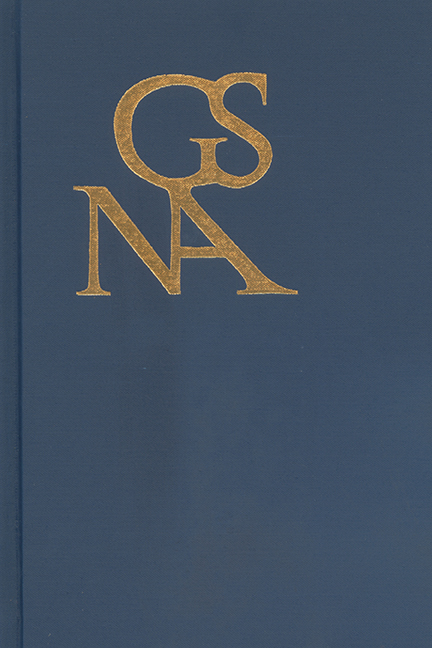Book contents
- Frontmatter
- Contents
- Building Bridges: Goethe's Fairy-Tale Aesthetics
- Goethe as Mystagogue
- Observing Neutrality, circa 1800
- Goethe, Faust, and Motherless Creations
- Impossible Ideals: Reconciling Virginity and Maternity in Goethe's Werther
- Kant, Calculus, Consciousness, and the Mathematical Infinite in Us
- The Classical Aesthetics of Schlegel's Lucinde
- Special Section on Visual Culture in the Goethezeit
- Acquaintance with Color: Prolegomena to a Study of Goethe's Zur Farbenlehre
- “Hamiltonian-Hendelian” Mimoplastics and Tableau of the Underworld: The Visual Aesthetics of Goethe's 1815 Proserpina Production
- J. W. Goethe and C. G. Carus: On the Representation of Nature in Science and Art
- Brentano's Remains: Visual and Verbal Bricolage in Gockel, Hinkel und Gackeleia (1838)
- A Book of Living Paintings: Tableaux Vivants in Goethe's Die Wahlverwandtschaften (1809)
- Book Reviews
A Book of Living Paintings: Tableaux Vivants in Goethe's Die Wahlverwandtschaften (1809)
from Special Section on Visual Culture in the Goethezeit
Published online by Cambridge University Press: 25 February 2017
- Frontmatter
- Contents
- Building Bridges: Goethe's Fairy-Tale Aesthetics
- Goethe as Mystagogue
- Observing Neutrality, circa 1800
- Goethe, Faust, and Motherless Creations
- Impossible Ideals: Reconciling Virginity and Maternity in Goethe's Werther
- Kant, Calculus, Consciousness, and the Mathematical Infinite in Us
- The Classical Aesthetics of Schlegel's Lucinde
- Special Section on Visual Culture in the Goethezeit
- Acquaintance with Color: Prolegomena to a Study of Goethe's Zur Farbenlehre
- “Hamiltonian-Hendelian” Mimoplastics and Tableau of the Underworld: The Visual Aesthetics of Goethe's 1815 Proserpina Production
- J. W. Goethe and C. G. Carus: On the Representation of Nature in Science and Art
- Brentano's Remains: Visual and Verbal Bricolage in Gockel, Hinkel und Gackeleia (1838)
- A Book of Living Paintings: Tableaux Vivants in Goethe's Die Wahlverwandtschaften (1809)
- Book Reviews
Summary
DURING HIS 1787 VISIT to Caserta, a town near Naples, Goethe recounts a private performance of a new art form by the lively young Lady Emma Hamilton. He describes how with the help of just a few scarves and with her hair undone, she manages to transition swiftly between innumerable po stures, gestures, and expressions, offering up a surprising spectacle, while the wealthy British ambassador and connoisseur Lord Hamilton holds out a light to illuminate her actions. Here Goethe describes his first (albeit fictional) encounter with Attitüden, a mimetic-plastic art in which a solo performer— usually a woman—imitates antique statues or general human affectations in rapid alternation. Goethe's introduction to these Attitüden, precursors to the more elaborate form of tableaux vivants, or live reenactments of paintings, incited him to direct numerous living image performances in Weimar in the 1810s with painter and art connoisseur Heinrich Meyer and his literary assistant Friedrich Wilhelm Riemer. Around 1809, he included a performance of a series of three tableaux vivants and a nativity scene in one of his most ambitious novelistic projects, Die Wahlverwandtschaften (Elective Affinities). These art forms, variously described as trivial and belonging to low culture, are means by which to reflect on the mediated and composite nature of representation—and its inability to be pinned down by recourse to a single artistic or narrative mode.
In order to do this, Goethe has two women, Ottilie and Luciane, enact or perform the scenes—either while physically present or allegorically, as physically absent but metaphorically present. In both cases these women enact the oppositions inherent in this hybrid art form described by the narrator as a new form of representation (“eine neue Art von Darstellung,”427). In a letter from 1813 to Meyer, Goethe described these live reenactments of paintings performed privately for entertainment in aristocratic circles as “Zwitterwesen zwischen der Mahlerey und dem Theater” (McIsaac 156; hybrid beings between painting and theater). They belied categorization according to Lessing's division between the semiotics of the visual and the verbal arts in his 1766 Laokoon oder über die Grenzen der Mahlerey und Poesie (Laocoon and the Limits of Painting and Poetry), foundational for Enlightenment aesthetics.
- Type
- Chapter
- Information
- Goethe Yearbook 23 , pp. 245 - 270Publisher: Boydell & BrewerPrint publication year: 2016



